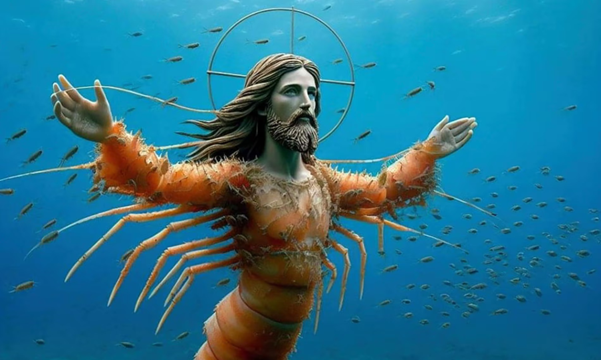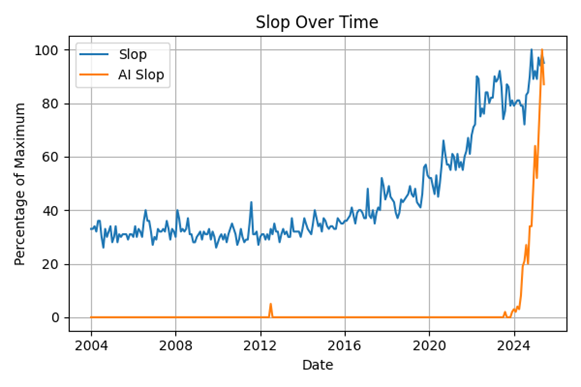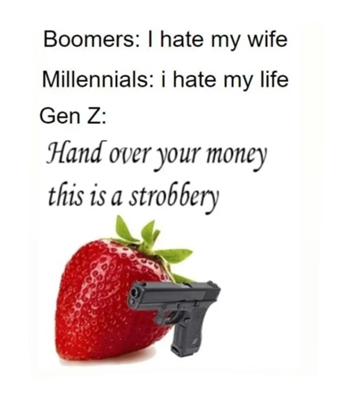Agnieszka Mensfelt
Machine Aesthetics
Preface
Do you have a moment to talk about our Lord and Saviour Shrimp Jesus?

This fairly blasphemous image is a canonical example of AI slop—low-quality content begotten by generative AI. But behold, before we—as ChatGPT would put it—delve into the meaning and extent of “AI slop”, let us first contemplate just “slop”. For the exegesis, we’ll consult Wiktionary, which provides the most complete and up-to-date definitions.
Enter: Figurative Slop
Specifically, we’ll consider slop as a noun, in its second set of meanings (countable and uncountable) [2]. Its etymology is likely traced to the Middle English sloppe, from Old English sloppe, and is related to slip. The first few definitions indeed correspond to slippery or easily spilled substances: (1) “semi-solid-like substance; goo, paste, mud, pulp”; (2) “scraps used as food for animals, especially pigs or hogs”; (3) “inferior, weak drink or semi-liquid food”; then we have dated (4) “human urine or excrement”; next (5) “domestic wastewater”; (6) “liquid carelessly spilled upon a surface; a soiled spot”. The next two are a bit divergent with (7) “fellatio” (slang)—although the connection is understandable here—and (8) “a dance popular in the 1960s” (dated). Definitions (1)–(6) give us a good grasp of the figurative meaning in entry (9): “Content or media of little-to-no value, especially that which is produced consistently and according to trends to satisfy a recommendation algorithm or consumerist demands.”, which belongs to the Internet slang and is described as derogatory. Let us pause for a moment here and consider Google Trends for the terms “slop” and “AI slop”:

Even before the emergence of “AI slop,” we can observe a rise in the popularity of “slop” after 2020—presumably not in the “fellatio” sense. It’s likely the figurative meaning, (9), which is broad and applicable to a wide array of creative content. As a pejorative term, we can use it to label any media we dislike, for whatever reason. However, its growing use, especially around 2022, wasn’t just from boredom with the insults we already had for botched TV shows. The rise of figurative slop reflects how technology is influencing the creative and entertainment industries.
Take the film industry. The never-ending feast of streaming services, optimized to retain viewer attention as long as possible, has become tough competition for theatrical releases—especially post-COVID. Producers rely heavily on what viewers already know and like: in 2024, all ten highest-grossing theatrical films were either prequels/sequels, remakes, or based on existing intellectual properties. Both theatrical and streaming content often feel like the product of algorithms designed to appeal to the widest possible audience, and, because of this averaging over preferences, appealing to no one at all. On YouTube and similar platforms, we encounter artificially inflated content, crafted to please the almighty algorithm and maximize revenue. Slop, the by-product of the attention economics, is polluting our digital environment.
Enter AI Slop
Slop didn’t need generative AI to emerge. Content farms [3] producing vast volumes of worthless articles and clickbait videos existed long before the first germs of Transformers architecture. What generative AI did was turbocharge the creation of waste content. It was a nuclear reactor allowing to scale up the manufacture into a factory, spewing the fallout of AI slop on us. Wiktionary defines the newest (10th) meaning of slop as: “junk output from generative artificial intelligence published on the Internet in large quantities, posing as human-made content” (artificial intelligence, derogatory). Incarnations of Shrimp Jesus, like the one depicted above, are prime examples. These nightmare-inducing amalgamations of Jesus with crustaceans were posted by bot profiles on Facebook, sometimes receiving multiple comments from other bot accounts, acknowledging it with “Amen”.
With the AI craze, algorithmic revenue optimization, and the constant battle for our attention, the landscape of the Internet changes. Once a global village where you might stumble upon a clumsy cat blog written by a kindred soul across the world, it’s now morphing into a Potemkin village. Or, if you will, to a backlot Western town. Only the lettering over the saloon door is unintelligible, and the tumbleweed rolling across the street glitches.

Enter: The Dead Internet Theory
Have you noticed this, how inhuman some online spaces have become? Well, the dead Internet theorists certainly have. This conspiracy theory [4] began gaining traction around 2021. It posits that most Internet content and traffic are now generated by bots, and that the “organic” Internet effectively died around 2016–2017. The supposed motive? Manipulation of the populace, allegedly orchestrated by governments.
Like all conspiracy theories, it does not have enough evidence to support its claims, but it addresses some tangible concerns. The traffic generated by bots increases. The bot accounts on social media platforms, dating apps, and all means of electronic communication proliferate. So do the videos with AI-generated images and a robotic voice reading generic click-baity stories.
In a widely discussed essay, “The Anti-Social Century” [5], Derek Thompson points out that the biggest social change in the 21st century is an anti-social turn, with people spending less time socializing and the amusements of the digital world becoming more alluring than those of the physical world. The abundance of clearly AI-generated content and interactions in the digital space may deepen the sense of alienation. However, regardless of the bots, AI slop also becomes a medium of human-to-human communication.
Prophecy from the Past: Neil Postman
In his 1985 book, Amusing Ourselves to Death [6], Neil Postman provided a sharp analysis of the influence of medium on communication. Reflecting on television culture, he argued that the shift from print to TV trivialized discourse. The informational role became secondary to advertisement. The message was packed into a flashy, easily digestible wrapping, and meaningful information was misplaced or lost. Postman believed the dystopia we were heading into was more Huxleyan than Orwellian—where society is numbed by entertainment rather than oppressed by terror.
This analysis seems well-suited to today’s digital culture, driven by advertisement and attention economics, with product placement present everywhere from TikToks to blockbuster movies. What has changed is the emergence of new channels of communication and new media.
One of Postman’s core ideas was an extension of Marshall McLuhan’s “the medium is the message,” which he developed into “the medium is the metaphor.” The medium constrains what kind of message can be communicated through it. What can be communicated using AI slop—this random regurgitation of words and images?
Well, for one thing: a sense of humour.
Case Study: Italian Brain Rot
“Italian brain rot” [7] began trending on TikTok in early 2025 and quickly went viral. “Brain rot,” Oxford’s Word of the Year for 2024 [8], describes both the effect of consuming too much unchallenging content and the content itself. It doesn’t have to be AI-generated—human-made slop counts too. But Italian brain rot is a quintessential example of AI slop.
It consists of eerie AI-generated videos featuring characters like a legged shark in blue Nike sneakers, Tralalero Tralala, and a ballerina with a coffee cup for a head, Ballerina Cappuccina, accompanied by background music and voice-over in Italian. The characters are creepily surreal, and the stories make no sense whatsoever. This brain rot exploded in popularity, sparking remixes, memes, live re-creations, and was promptly utilised in marketing.

One reason for its appeal may be that it caters to Gen Z humour. This generation’s meme style is starkly different from that of Millennials or Boomers, as neatly summarised by memes that explicitly contrast generational humour [9]:

Humour is said to be a coping mechanism. If so, Gen Z has chosen to cope with absurd reality in much the same way as their 1920s Dadaist forebears—by embracing absurdism. They developed a brand of humour and creative output that some have christened “neo-Dada,” and the surreal and meaningless AI slop became one of their forms of expression.
Afterword
To wrap up this millennial-Matuzalem’s Jeremiad: is the digital landscape truly bleak? Are we drowning in a biblical-sized deluge of AI slop? Does it confirm Postman’s prophecy? Are we living in a Huxleyian dystopia? Have we chosen to drug ourselves with entertainment, and has AI slop become our Soma (or Slop-ma)? Is the only way out to follow the example of Huxley’s Savage?
Maybe. But the good news is that while the Internet as we know it may be dying, human creativity is not. Italian brain rot, for instance, inspired a multitude of creative reinterpretations—human-made ones. Internet culture absorbs AI slop and transforms it into both a form of communication and ironic meta-commentary. Still, at the end of the day, we can choose how to direct our attention and creative powers. And in those moments when digital desolation overwhelms us, we can turn to the appreciation of some dank Gen Z memes. Tralalero Tralala. Amen.
References
[2] https://en.wiktionary.org/wiki/slop [Accessed: 04.06.2025]
[3] https://en.wikipedia.org/wiki/Content_farm
[4] https://en.wikipedia.org/wiki/Dead_Internet_theory
[6] Postman, Neil (1985). Amusing Ourselves to Death: Public Discourse in the Age of Show Business. USA: Penguin. ISBN 0-670-80454-1.
[7] https://en.wikipedia.org/wiki/Italian_brainrot
[8] https://corp.oup.com/news/brain-rot-named-oxford-word-of-the-year-2024/ [9] https://www.reddit.com/r/GenZ/comments/hf8b7q/strobberry/
Image References
Figure 1 – “Shrimp Jesus” AI-generated image
Source: Uploaded to Facebook, and used as an example of AI slop by the Guardian: Hern, Alex (2024-05-19). Spam, junk … slop? The latest wave of AI behind the ‘zombie internet’. The Guardian. ISSN 0261-3077.
License: Public Domain*.
Date created: 18 May 2024
Date uploaded: 4 October 2024
Figure 2 – Plot
Creator: Agnieszka Mensfelt
Source of data: Google Trends (accessed June 2025)
Figure 3 – Condition of the Internet
Creator: Agnieszka Mensfelt (AI-generated using DALL·E 3)
Source: Created by the author
Figure 4 – “Tralalero Tralala” (shark character on the beach)
Link: https://en.wikipedia.org/wiki/Italian_brainrot#/media/File:Tralalero_Tralala.webp
Creator: @amoamimandy.1a
Created/Uploaded: 16 April 2025
License: Public Domain
Figure 5 – “Boomers / Millennials / Gen Z Humour” meme
Meme version creator/uploader: Reddit user HBekaar
Link: https://www.reddit.com/r/GenZ/comments/hf8b7q/strobberry/?utm_source=embedv2&utm_medium=post_embed&utm_content=action_bar&embed_host_url=https://www.buzzfeed.com/daves4/gen-z-humor
Template origin: Probably unknown creator
License: No explicit free license. Used here under fair use for commentary.